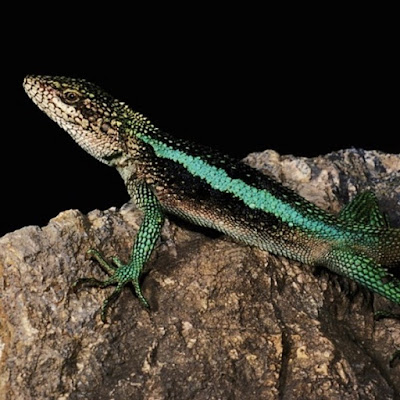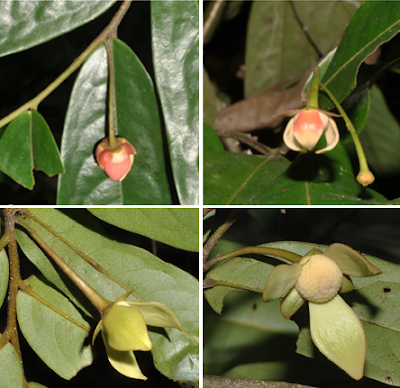[Most Recent Entries] [Calendar View]
Saturday, September 16th, 2017
| Time | Event | ||
| 8:50a | [Crustacea • 2016] Rathbunamon chumomrayense • A New Species of Semi-Terrestrial Freshwater Crab (Decapoda: Brachyura: Potamidae) from the Central Highlands of Vietnam Abstract A new species of semi-terrestrial crab of the family Potamidae, Rathbunamon chumomrayense sp. nov. is described from Chu Mom Ray National Park, the Central Highlands of Vietnam. The new species can be distinguished from R. lacunifer (Rathbun, 1904), the only other species in the genus, by a suite of characters, including the slightly more rugose anterolateral regions, confluent epigastric and postorbital cristae that are sinuous, less convex anterolateral margins, relatively shorter fingers of the chelipeds, and the terminal segment of the male first gonopod being slightly curved outwards, with narrower dorsal flap. Keywords: Crustacea, semi-terrestrial crabs, taxonomy Introduction The freshwater crabs of Vietnam are currently represented by 52 species, belonging to two families, Potamidae Ortmann, 1896 and Gecarcinucidae Rathbun, 1904 (Dang & Ho, 2012; Dang, Thai, & Pham, 1980; V.T. Do, 2014; V. T. Do, Le, & Nguyen, 2016; V. T. Do, Le, & Phan, 2015; V. T. Do, Shih, & Huang, 2016; Naruse, Nguyen Xuan, & Yeo, 2011; Ng & Yeo, 2001; Yeo & Ng, 1998; Yeo & Ng, 2007). Rathbunamon is a monotypic genus established by Ng (1996) with R. lacunifer (Rathbun, 1904) as the type species. A recent survey in the Central Highlands of Vietnam obtained two specimens which are here identified as a second species from this genus. The new species possesses the main generic characteristics of Rathbunamon. It appears to have a highly localized distribution and can be distinguished from its congener by a suite of morphological characteristics.
Taxonomy Family Potamidae Ortmann, 1896 Subfamily Potamiscinae Ortmann, 1896 (sensu Yeo & Ng 2003) Rathbunamon Ng, 1996 Rathbunamon chumomrayense sp. nov. Etymology. The new species is named after the type locality, Chu Mom Ray. Ecological notes. This species inhabits forested mountain areas. The larger specimen was found running around on the forest floor, far from the stream; however, the smaller specimen was found near the stream. It is believed that this species spends most of their time in the terrestrial environment Van Tu Do, Van Dong Dang, Thi Kim T. Cao and Ngoc Khac Hoang. 2016. A New Species of Semi-Terrestrial Freshwater Crab (Crustacea: Decapoda: Brachyura: Potamidae) from the Central Highlands of Vietnam. Zootaxa. 4179(2); 279–287. DOI: 10.11646/zootaxa.4179.2.8 | ||
| 9:19a | [Herpetology • 2017] Japalura slowinskii • A New Species of Japalura (Squamata, Agamidae) from the Nu River Valley in southern Hengduan Mountains, Yunnan, China
Abstract A population of Japalura from Yunnan Province, China, previously assigned to Japalura splendida, is described as a new species. The new species has been recorded between 1138–2500 m in the Nu River drainage between the towns of Liuku and Binzhongluo, and on the lower western slopes of the Nushan and eastern slopes of the Goaligongshan. The new species can be distinguished from other species of Japalura, except J. dymondi, by the following combination of characters: exposed tympani, prominent dorso-lateral stripes, and small gular scales. It is very similar with but differs from J. dymondi by having smooth or feebly keeled dorsal head scales, three relatively enlarged spines on either side of the post-occiput area, strongly keeled and mucronate scales on occiput area and within the lateral stripes, back of arm and leg green, higher number of dorsal-ridge scales (DS) and fourth toe subdigital scales (T4S). A principal component analysis of body measurements of adult male specimens of the new species and J. dymondi showed principal component 1 loading highest for upper arm length, fourth toe length and snout to eye length and principal component 2 loading highest for head width, head length and fourth toe length. Keywords: Agamidae, Japalura sp. nov., Goaligongshan Mountain, Nujiang River Valley, Hengduan Mountains, Yunnan, China Japalura slowinskii sp. nov. Diagnosis: A large species of Japalura with a robust head and body compressed dorso-ventrally; SVL = 89.6±5.44 mm (n = 18; Male); SVL = 83.9±6.71 mm (n = 7; Female); smooth or feebly keeled dorsal head scales; exposed tympani; a transverse gular fold; a distinct oblique fold anterior to shoulder extending dorsally from transverse gular fold and continuing posteriorly beyond shoulder; dorsal scales heterogeneous, larger scales strongly keeled; a broken dorso-lateral row of enlarged and strongly keeled scales separated from dorsal crest scales by one large or two smaller scales, and separated from each other by one or two small scales; tail in adult males slightly swollen posterior to base; dorsum of males black with a turquoise dosolateral stripe on either side of mid-dorsal crest: fore and hind limbs green. Etymology: The specific epithet is a patronym honoring our late friend and colleague Joseph Bruno Slowinski. The epithet is a masculine noun in the genitive case. Dr. Joseph B. Slowinski worked in CAS until his death on September 11, 2001 in north Myanmar a bite from a krait during a field expedition at the age of 38 years old, when he was in charge of both the projects of Myanmar Biodiversity Survey, and the China Natural History Project — the NSF-funded Gaoligongshan Project (collaborative project between KIZ, KIB, and CAS). Distribution and Natural History: Japalura slowinskii has only been found within the Nu River Valley drainage system between the town of Liuku, Liushu County, and the town of Binzhongluo, Gongshan County, a northsouth distance of approximately 210 km (refer to Figure 1). The species has been found on the western slopes of the Nu Shan and the eastern slopes of the Goaligongshan between elevations of 1 138–2 500 m. J. slowinskii has not been recorded on the eastern slopes of the Nushan or the Hengduan Shan, or on the western slope of the Goaligongshan; however, these areas have not been thoroughly surveyed for reptiles. It is unlikely that the species extends beyond the western slopes of the Goaligongshan because of the high altitude of the ridge (above 3 000 m [Chaplin, 2005]). A recent collecting trip (2005) to Dulong Valley, west of the Goaligongshan ridge, only recorded a single agamid species, Pseudocalotes kingdonwardi. .... Dingqi Rao, Jens V. Vindum, Xiaohui Ma, Mingxia Fu and Jeffery A. Wilkinson. 2017. A New Species of Japalura (Squamata, Agamidae) from the Nu River Valley in Southern Hengduan Mountains, Yunnan, China. Asian Herpetological Research. 8(2); 86–95 DOI: 10.16373/j.cnki.ahr.160053http://www.ahr-journal.com/Upload/PaperU | ||
| 10:05a | [Botany • 2017] Polyalthia yingjiangensis • A New Species (Annonaceae) from the China/Myanmar Border
Abstract Polyalthia yingjiangensis sp. nov. is described from the China/Myanmar border. It is distinct in having outer petals that are much shorter than the inner petals and having a very long pedicel. It is most similar to P. miliusoides I.M. Turner, but differs in having perianth parts that are glabrous adaxially and pubescent abaxially, thicker and sparsely pubescent pedicels, as well as verrucose and darker monocarps. Polyalthia yingjiangensis Y. H. Tan & B. Xue sp. nov. Etymology: The new species Polyalthia yingjiangensis is named after its type locality, Yingjiang county of Yunnan province, China. Bine Xue, De-Ping Ye, Yun-Yun Shao and Yun-Hong Tan. 2017. Polyalthia yingjiangensis sp. nov (Annonaceae) from the China/Myanmar Border. Nordic Journal of Botany. 35; 476–481. DOI: 10.1111/njb.01612 | ||
| 10:38a | [Paleontology • 2017] Arminisaurus schuberti • A Rare New Pliensbachian Plesiosaurian from the Amaltheenton Formation of Bielefeld in northwestern Germany
Abstract We describe a new plesiosaurian from the upper Pliensbachian Amaltheenton Formation of Bielefeld in northwestern Germany. The taxon is based upon an incomplete associated skeleton comprising part of the right mandibular ramus, several teeth, a series of cervical, pectoral, dorsal and caudal vertebrae, as well as ribs, limb girdle elements including a nearly complete right scapula, and various distal limb bones. A unique character state combination serves to distinguish the Amaltheenton Formation remains from other previously documented Early Jurassic plesiosaurians. The most important features are the presence of a longitudinal notch incising the posterior rim of the glenoid fossa and retroarticular process, and a pronounced ventrolateral shelf on the scapula, both of which constitute derived states otherwise shared with Early Cretaceous leptocleidians. However, phylogenetic analysis using a ‘total group’ Plesiosauria data-set that specifically accommodates for Pliensbachian taxa unanimously placed the Amaltheenton Formation plesiosaurian among Early–Middle Jurassic pliosaurids. This discovery is significant because it reveals unexpected homoplasy, but also because it establishes what is only the third formally named plesiosaurian taxon thus far documented from Pliensbachian strata worldwide. Key words: Plesiosauria, Early Jurassic, pliosaurid, ‘Pliensbachian gap’. Systematic palaeontology SAUROPTERYGIA Owen, 1860 PLESIOSAURIA de Blainville, 1835 PLIOSAURIDAE Seeley, 1874 Arminisaurus gen. nov. Etymology. Armini-, referring to Arminius (Armin), chieftain of the Germanic Cherusci tribe who defeated a Roman army in the Battle of the Teutoburg Forest; and -saurus Latinized Greek for ‘lizard’. Arminisaurus schuberti sp. nov. Etymology: The species name honours Mr. Siegfried Schubert, who recovered the holotype NAMU ES/jl 36052 for science and has contributed to palaeontological research in the Bielefeld region for the last decade. Type locality and unit. Beukenhorst-II claypit in the Jöllenbeck district of Bielefeld, North Rhine-Westphalia, northwestern Germany. Type stratum is the upper Pliensbachian (Lower Jurassic) middle Amaltheus subnodosus Subzone (Amaltheus margaritatus Zone) of the Amaltheenton Formation. Sven Sachs and Benjamin P. Kear. 2017. A Rare New Pliensbachian Plesiosaurian from the Amaltheenton Formation of Bielefeld in northwestern Germany. Alcheringa. DOI: 10.1080/03115518.2017.1367419 Ancestor of sea reptile super-predators found in Germany http://phy.so/424681896 via @physorg_com |
| << Previous Day |
2017/09/16 [Calendar] |
Next Day >> |










